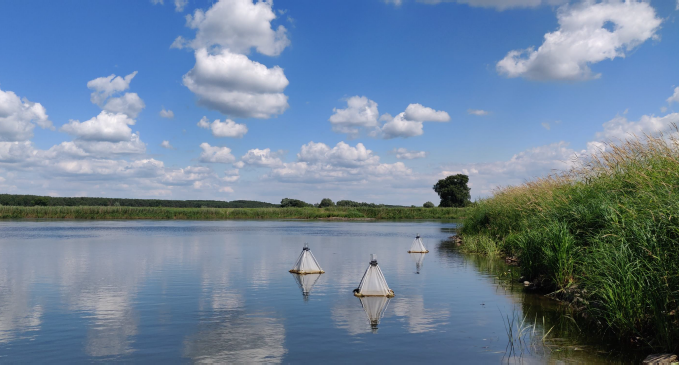Insect emergence on the river Oder and its floodplain waters
Floodplains as a refuge for aquatic insects after an environmental disaster?

Within the framework of ODER~SO (www.oder-so/info), we are investigating the effects of the mass development of the toxin-producing brackish water golden alga Prymnesium parvum on the emergence of aquatic insects.
Aquatic insects - such as mosquitoes, caddisflies or mayflies - are characterised by a change of habitat during their development. They live as larvae in the water and leave the water as adults (emergence) to reproduce. They are an important part of the food web in aquatic and terrestrial habitats. Both the larvae in the water and the adult insects on land play an important role in the respective food web as consumers and/or prey. Through their emergence, aquatic insects contribute significantly to a cross-ecosystem transfer of energy and nutrients.
However, if an aquatic ecosystem is disrupted, as was the case with the environmental disaster in the Oder, this could have far-reaching consequences for neighbouring terrestrial ecosystems. The sudden algal bloom in the summer of 2022 led to a massive die-off of fish and molluscs. However, it is currently unknown how the algal bloom has affected the species richness and abundance of aquatic insects.
Neighbouring floodplains were not as severely affected by the algal bloom in the Oder as the river itself, as they were not connected during the summer. Therefore, floodplain waters could play an important role in the recovery of aquatic insect communities after environmental disasters in neighbouring river systems. Aquatic insect larvae can drift from the floodplain to the river during spring floods or the adult insects can fly from the floodplain to the river in summer to lay eggs, leading to the recolonisation of river ecosystems by certain species.


We are investigating the changes in the species community (biodiversity) after the algal bloom in the floodplains and in the river, to what extent the floodplain waters serve as a refuge and how the aquatic insects influence neighbouring terrestrial habitats. To this end, we deploy floating insect traps at six sites on the German side of the Oder. At three of the sites, we also sample neighbouring floodplain waters that are connected to the river during spring floods. In addition, we use terrestrial Malaise/window hybrid traps to document changes in the insect species community depending on the distance to the floodplain or river. The data will shed light on the role of floodplains as refuges for aquatic invertebrates in the event of an environmental disaster.

Background information
During the environmental disaster in the Oder in the first three weeks of August 2022, an estimated 1000 tonnes of fish died along a stretch of more than 300 km of the Oder, as well as a significant proportion of mussels, water snails and presumably other invertebrates. Some of the fish species affected, such as the Atlantic sturgeon and the Baltic golden stone loach, only occur in the Oder, while Baltic houting, zope and burbot have their main distribution area here in Germany. According to the findings of the German expert group, the massive mortality of aquatic organisms was caused by a combination of different factors. Massive discharges of common salt, together with the very low water flow of the Oder, its high nutrient load and a prolonged period of sunshine, enabled a mass proliferation of the toxin-releasing brackish water alga Prymnesium parvum in one or more upper parts of the Oder system, which then moved downstream, presumably continuing to grow (https://de.wikipedia.org/wiki/Umweltkatastrophe_in_der_Oder_2022)
Such increased salt concentrations have already been measured in the Oder in the past, so that a repetition cannot be ruled out if high salt loads continue to be discharged into the Oder or are discharged again at low water. Furthermore, the occurrence of these algae in other saline waters cannot be ruled out. For the survival of some of the fish populations in such toxin waves, side waters of the floodplains are of considerable importance, provided they are still connected to the main river course. In addition, the dynamic types of floodplain waters are characterised by a particularly high level of biodiversity. However, the lateral connectivity required for the refugial function, habitat function and other ecosystem services of floodplains is being greatly reduced in the Oder as groyne construction on the Polish bank progresses.
ODER~SO - Incident-related Special Investigation Programme for the Environmental Disaster in the Oder River in August 2022
Funding:
DLR Projektträger, im Auftrag des BfN Bundesamt für Naturschutz, FKZ: 352357010A
Period:
11/23 - 04/26
Keywords:
Oder, aquatic insects, insects, emergence
Researchers:
D. Martin-Creuzburg
N. Heitmann
T. P. Parmar
J. Rüegg
Cooperation partners:
Leibniz-Institut für Gewässerökologie und Binnenfischerei Berlin link
Helmholtz-Zentrum für Umweltforschung GmbH (UFZ) Magdeburg link
Institut für Binnenfischerei Potsdam-Sacrow, Universität Duisburg-Essen (UDE) link

